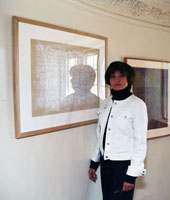A banana in a grocery store is an excellent source of potassium. You go to the grocery store for practical reasons. You evaluate the displayed fruits and vegetables according to how they will benefit your body. You pay money for things that will impact your life and improve it immediately.
A banana taped to a museum wall is a mind game.
You go to the museum for no practical reason at all. The entrance you pay at a museum doesn’t get you anything. Why on earth would you go to such a place?! You go precisely because you feel it’s time for a mind game. You want to have your brain scrambled. Name a piece of art that didn’t have that effect on you!
Correction: Name a piece of MODERN Art that wasn’t a mind game. That’s because art since the middle of the 19th century has engaged the viewer in the literal sense of that word, meaning involve. Meaning you have to think about it, to puzzle it out.
Engaging with Modern Art means identifying your assumptions and expectations. That takes practice.
You don’t even have to go to a museum to practice that, you can do it anywhere, with anything. Right now, for example. Go to your kitchen and look at a banana and at the assumptions you have in your head about its characteristics, like the color yellow.
Becoming aware of your assumptions and expectations is actually easier in a museum than in your kitchen. That’s because in the museum the objects are already taken out of their normal, habitual context. A banana taped to a museum wall is a mind game if you stare down your assumptions about what’s supposed to be on museum walls and what art is supposed to be.
If you think museums should show this…
and this…
and this…
…you’re also being asked to play mind games. You may think that ancient images are more real and therefore not mind games. But that’s because we tend to be in awe of very old objects, whether coins, pottery, murals, inscriptions, monuments or paintings. Even in their own day, they already were mind games.
Actually, you don’t have to think about anything. But what’s the fun in that?
I recommend this article:
https://www.nytimes.com/2020/09/18/arts/design/banana-art-guggenheim.html
All contents copyright (C) 2010 Katherine Hilden. All rights reserved.







Wonderful article Katherine! Too bad we didn’t think up this idea…we could have made a fortune! 💵
Keven
Keven Wilder Cell: 773.636.6289 http://www.kwilderart.com http://www.fairdealcommittee.com instagram.com/kwilderart
>
My garden is producing tons of winter squash. Would that do? No, because bulky squash would be too hard to tape and too hard to replace. You can buy bananas year round, but squash not so much. So on that count the banana is a workable choice. But not so fast. What about politics and economics, as in Banana Republic? What if the banana growing countries, having learned that some gringo paid $120,000 for one banana, raise their price to that level! What then, art majors? Will supply side economics and trickle down become art historical concepts? The Guggenheim curators are working on it. They may decide to change their whole devotion to the-shock-of-the-new and encourage, oh, knitting instead. I can imagine knitting classes being held at the Guggenheim, can’t you? Look at the building. Frank Lloyd Wright clearly designed it as a knitting basket. I think this is a strand that can be developed further, but let’s stop there for today.